How to achieve and prolong tulip bloom
After a few weeks, you will notice that the potted bulbs are sprouting. As soon as the seedlings reach a height of 6-7 cm, it is time to transfer them to the room and gradually accustom them to daylight, at first covering them with a paper cap. It is desirable that the temperature also rise gradually, within two to three days, up to +18 ° C. At a higher temperature, tulips at home will form weak, thin peduncles, possibly even damage to plants by Fusarium.
If you are growing your tulips at home in winter, provide them with artificial light for ten hours, otherwise the stems will be very elongated, and the color of the flowers will be pale.
With the appearance of colored buds, it is recommended to rearrange the tulip pot closer to the cold glass of the window, since at a lower temperature, the flowering period will stretch, and you will be able to admire the delightful flowering of tulips for a longer time.
To extend the flowering period, it is also advisable to take out the pots with tulips to the balcony at night, and spray the leaves with warm water during the day (without getting on the flowers). The required air humidity level for tulips is about 80%. The soil should also be constantly slightly moistened.
Important subtleties:
- the bright sun should not shine on tulips;
- protect plants from drafts;
- keep flower pots as far away from central heating radiators as possible;
- for irrigation, it is recommended to use settled water at room temperature;
- cut domestic tulips at the very surface of the earth, in the early morning before watering.
After home cultivation, the bulb is greatly depleted and it is no longer possible to reuse it for the same purpose, but you can plant it on the garden bed - the bulbs will recover in the open field, and the next year the tulips will bloom again (but already in the flowerbed). Therefore, with the end of flowering, the buds of domestic tulips are broken off and watering is gradually reduced until the leaves turn yellow, then the bulbs are dug up, dried and stored at a temperature of +14 degrees in a dry basement.
The video attached to the article will allow you to better understand how to plant tulips at home. Following the recommendations, you will definitely be able to achieve excellent results and admire the exquisite buds on long winter evenings in anticipation of spring.
Botanical description
The dwarf tulip is otherwise called a low tulip, a crooked tulip. It belongs to the genus Tulip of the Liliaceae family. In nature, dwarf tulips grow in South-West Asia (Turkey, Iran), in the Caucasus. Their main residence is at an altitude of about 2500-3000 meters, on a stone surface. That is why dwarf tulips are called the inhabitants of the alpine belt.
Every element of this plant is characterized by minimalism in everything. Plant height is only 10-12 centimeters, the diameter of tiny ovoid bulbs is 1-2 centimeters.
The leaves of the dwarf tulip are also miniature, about 5 to 12 centimeters long. The maximum width is 1 centimeter. The shape is linear, there are few of them on the stem, usually 3-5 pieces. They are located closer to the root, sometimes they just lie on the ground at the base. First of all, leaves come out green with a silver tint. If you choose a sunny place for disembarkation, then a red frame will appear on the leaves from direct rays.
The flowers are wide, bell-shaped, with pointed petals. The variety of palette inside the petal is surprising and even mesmerizing: from white to maroon.The color in the middle can be radically different from the main color. Some varieties represent color asymmetry, and there are those when the flower is fluffy and feels like velvet when touched.
The dwarf tulip is not the only one of its kind. He has several varieties. Of course, he cannot boast of a huge variety, like his associates. But its advantage is that all varieties look original, unique and sophisticated. Every lover will find a plant to his liking. When choosing a variety, the guideline is directed towards the color palette, decorative characteristics and the individual needs of the gardener.
Popular varieties
Here are the most popular varieties of dwarf tulips:
Blue Baby - a delicate flower with sky-colored petals;
Schrenck's tulip belongs to the genus Tulipa of the Liliaceae family. It is a herbaceous perennial. Propagated by bulbs up to 3 cm in diameter.
This plant was named after Alexander Ivanovich Schrenk, a travel scientist who discovered it in 1873. Distribution area: Ukraine, Kazakhstan, Central Asia, China, Iran. In our country, it grows in the south and southeast of the European part, covering the territory from the Voronezh and Saratov regions to the Kalmyk Republic, Krasnodar Territory and Crimea. Habitat - steppes, semi-deserts and deserts.
The height of the plant is 40 cm. The peduncle stem is bare, at the top it may have a red tint. Leaves are sessile, without petioles, mainly 3 pieces (sometimes 4). The edge of the leaf is wavy. The structure of the flower is of the cup-lily type. The petals are pointed at the ends. The size is 7 cm.
There is a yellow spot in the middle of the bud. Anthers and stamens are black or yellow. The fruit is 4 cm in size. It is a round or ellipsoidal box with three sides. The color of the flowers ranges from snow-white to purple. Sometimes you can find motley colors.
Schrenck's tulip is an ephemeroid, that is, it is a plant with a short growing season. It blooms from the second half of April to mid-May. A month later, the fruit ripens, which contains about 240 seeds. After drying, the fruit is opened and the seeds are scattered with the help of the wind.
The new plant will bloom only after 6-7 years. A bulb with one juvenile leaf will grow first. In this case, the bulb will go 3 cm deep. The next year, a real leaf is formed. It takes another 3 years for the bulb to grow. And only after 6-7 years, an adult plant with 3-4 leaves and a flower is formed. After the plant has faded, the adult bulb dies. Her baby will remain, which will bloom next year.
Why does the onion shrink?
Many gardeners are faced with the problem that after planting a full-fledged developed bulb in a couple of years, and maybe already the next year, it becomes much smaller in size, does not bloom, and after a while it may disappear altogether. There is only one reason for this behavior of a flower - you simply do not follow the cultivation technology. The following are the reasons that can affect the chopping of a tulip bulb:
If you have been growing tulips in one place for more than 3 years, then the bulb will shrink;
The bulb was dug out too early. Tulip bulbs need to be dug out when the foliage has already withered;
If you plant the bulb too early, it will not have time to take root or even start growing while in the ground. You need to start planting when the soil heats up to plus 5 - 8 degrees Celsius. This is the period that begins in late September - early October;
Incorrect storage conditions for planting material. The bulb is stored either in high humidity conditions or in a very dry room. You need to store the bulbs in a dark place;
Improperly prepared soil for planting new bulbs and, as a result, inappropriate physical properties of the soil, its nutritional composition and light conditions;
Onion chopping is also affected by extreme conditions. It can be drought in spring or autumn, or vice versa, excessive soil moisture due to frequent rains.
During the dry season, the planting site of the bulbs should be watered regularly;
Unhealthy bulbs cooked for planting;
It is important not to miss the period of fruiting and seed ripening. This takes a lot of energy from the bulb itself, so the wilted flower must be removed immediately;
Do not cut tulips for a bouquet at the very base.
How to choose planting material?
We recommend that you familiarize yourself
As for how to grow tulips at home, first of all you need to choose a suitable flower variety. And this must be done as carefully as possible. The fact is that some varieties of tulips are quite capricious and can grow poorly in difficult home conditions. Therefore, you need to choose resistant varieties.
Experts recommend options such as London, Parade, Aristocrat and Battle Lustig for growing on the windowsill. A tulip variety like Parade is the most successful option for novice florists. It's easy for him to create good growing conditions.
When choosing the right tulip variety, you should pay attention to the size of the flower. Low-growing plants are considered less susceptible to disease, so they will grow well at home.
It is necessary to choose tulip resistant species.
Where exactly to get the bulbs does not matter. Planting material can be bought at a specialty store or dug up in the garden bed. It is believed that those tulips that were purchased from specialists are more suitable for home distillation, since their bulbs have already been properly processed, and harmful microorganisms can be brought into the house from the garden.
If the bulbs were taken from the street, they must be thoroughly processed before planting. It consists in thoroughly drying it after digging it out of the ground. The bulbs should be stored initially at a temperature of 35 ° C, and then transferred to a room where + 20 ° C. So the planting material can be stored for up to 2 months. For a longer aging of the bulbs, it is worth placing them in a cool room, but the temperature in the room should not be lower than + 15 ° C.
Aged material can lie for a long time. If you pack the bulbs in gauze bags and put them in the refrigerator in the vegetable storage section, they will feel fine here until it is time to disembark. For such planting material, excellent germination is guaranteed. Moreover, beautiful buds will appear very soon.
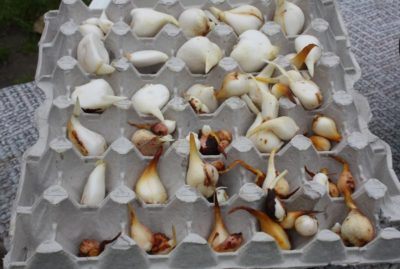
How to care?
Planting the bulbs is not enough to produce beautiful, healthy flowers. The process of rooting and flowering requires constant monitoring and timely response. Bulbs stay in the soil all winter. The soil can dry out quickly, and then it needs regular abundant irrigation. When the first petals appear, you need to "feed" the plants with a new portion of fertilizers. In the spring, top dressing is required. It is carried out in 3 stages.
After the snow melts. Thus it is necessary to loosen and "feed" the soil with organic fertilizer - 50 g per 1 square meter.
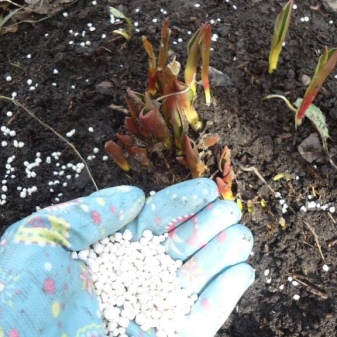
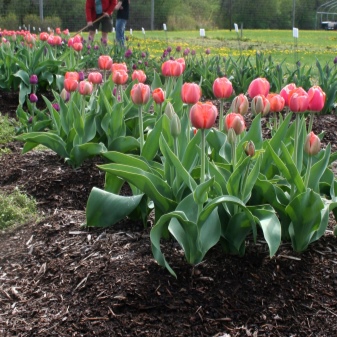
As it fades, it is recommended to remove faded flowers by hand. And the leaves are left to dry on their own along with the stem. If a support was attached to the stems, it should be carefully removed.
In order for the next tulip crop to be as bright, beautiful, healthy, it is necessary to dig out the bulbs annually. This is done in the summer, after the flower has finally wither. The bulbs are taken out, thoroughly cleaned, examined and heated for 2-3 days in the air.
Rotten, damaged - disposed of immediately. After that, the whole bulbs are finally cleaned, left in a warm place until August. Beginning in mid-August, the bulbs are stored in a cool, dry place without the penetration of sunlight.In this form, storage lasts until late autumn - the time of the next planting.

Parrot tulips are self-sufficient and temperamental plants. They do not tolerate bulbous neighborhoods. And they also do not like when flowers grow nearby that can compete with them in beauty and complexity of nursing. Tulips require a single plant or simpler neighbors as a backdrop and emphasize their individuality. Conifers can become optimal neighbors. In addition to emphasizing the expressiveness of tulips, they also become good defenders from bad weather conditions.
More modest and stunted plants that can claim to be close to parrot tulips:
- peonies;
- forget-me-nots;
- milkweed;
- shaved;
- daisies;
- rezuha.
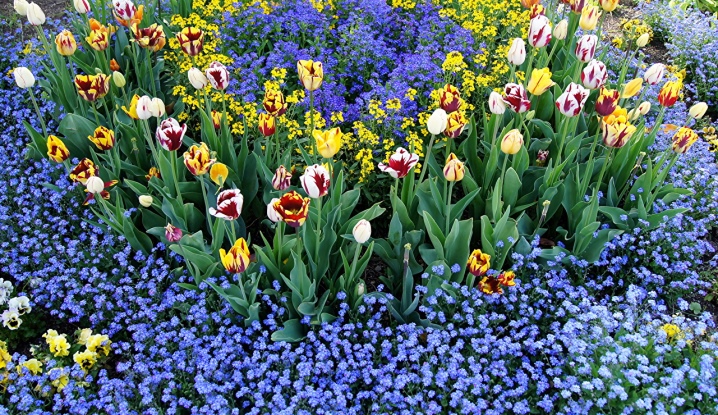
It is important to decide in advance which tulip variety is preferable for growing. Based on this, neighbors should be chosen not only for their simplicity and unpretentiousness, but also for the color combination with the main inhabitants of the garden
You can combine 2 or 3 varieties without using other plants. Moreover, in May, the garden will look like a rainbow.
How to grow large quantities of tulips for sale at home by March 8?
Some are so good at growing tulips at home that they are now planting flowers for sale. At the same time, there is an opportunity to get seedlings no worse than from a personal plot.
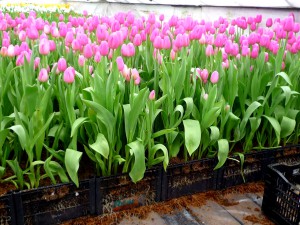
What you need:
- boxes, at least 15 cm deep, or plastic containers;
- the soil;
- chilled onions.
A favorable time for planting is early September.
As you know, tulips germinate in the spring, as soon as the first snow begins to melt. In this case, the bulb undergoes temperature changes, and also depends on moisture. It is these factors in the spring that are the most favorable for the flower and contribute to its active growth.
Know
It is not difficult to grow tulips for sale even in winter, the main thing is to observe the correct regime, from time to time rearranging the boxes from one environment to another.
The soil
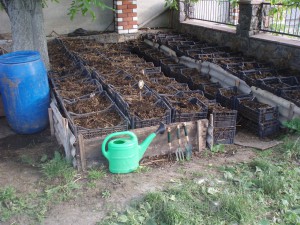
Prepare the soil substrate:
- river sand (1 part);
- sod (2 parts);
- humus (part 1).
You can buy ready-made soil, for this order bags of soil in a flower shop. Selected boxes are ½ filled with prepared soil.
Making a drainage layer
To prevent water from stagnating, it is necessary to prepare a drainage layer. For these purposes, use:
- expanded clay;
- moss-swagnum;
- sawdust;
- and other materials.
Preparing the bulbs
First, take a good look at the planting material. Remove bulbs with signs of rot and mold. Now soak them for about 30 minutes in a pale pink potassium permanganate solution.
It's important to know
Potassium permanganate disinfects the surface of the bulb, kills bacteria and prevents the occurrence of diseases in flowers.
Ground penetration

Planting material is placed in a box in rows - the bulbs should be 1 cm apart. Now the bulbs are embedded in the soil and sprinkled with earth to the top. Water abundantly. The earth shrinks.
As with growing in pots, the tulip should be 1/3 airborne. If, after watering, the ground subsided very much, then add more substrate - to the desired distance.
Where to put the boxes?

First, the boxes are placed in a dark, cool room, the temperature of which is 10 degrees. This makes it possible to create conditions close to the natural growing environment of tulips. Your bulbs will sprout quickly.
Plants should be watered from time to time.
A little advice
The main thing is not to pour the flowers, so that mold does not form on the ground. One watering per week is enough.

When buds appear, move the boxes with flowers again to a cooler place. For this purpose, you can choose cold window glass. It is the low temperatures that contribute to the fact that the buds will bloom much longer.
Extending the flowering of a tulip
Tulips cannot tolerate dry air - in the natural environment they germinate at a humidity of 80%.
Spraying with water, but so that it does not penetrate the buds (because of this, they can fade).
How to grow tulips by March 8: the right lighting

Flowers need to be taught to daylight gradually. For this purpose, the sprouts are first covered with a paper cap. The air temperature is also regulated by increasing it gradually.
It's important to know
If you immediately transfer the flowers to a room with room temperature, the stem of the flower will be thin, which will not allow the bud to gain all its power. In addition, a plant may develop a disease such as fusarium (damage to the leaves of a flower).
Consequences of a lack of light
Poor illumination leads to lengthening of the tulip stem, and the color of the petals turns out to be too pale.
What conditions must be met in order to admire the tulips in the flower bed for as long as possible?
Tulips grow well in a flower bed if certain conditions are met:
- The flower bed should be located in a sunny place protected from the wind;
- For tulips, loose nutritious soil is suitable, which has a neutral or slightly acidic reaction. A prerequisite is the introduction of top dressing. For the first feeding, you can use 30 g of nitrogen, 20 g of potash and 30 g of phosphorus fertilizer per bucket of water. It is carried out immediately after the first shoots hatch. The second top dressing (20 g of nitrogen, 20 g of potash and 30 g of phosphorus) is applied just before flowering, and the third (20 g of potash and 30 g of phosphorus), after the flowering period is over;
- Proper preparation of the site before planting the bulbs has a huge impact on the growth of tulips. The flowerbed needs to be dug up with the introduction of a complex of fertilizers one to two weeks before planting. Experienced gardeners usually do this. For one square meter, it is necessary to add 5 kilograms of humus or compost, 50 grams of nitrophoska and 30 grams of potassium salt. If your site is constantly flooded with melt or ground water, it is imperative to make drainage or organize high beds with deep aisles;
- During dry periods, it is necessary to maintain an optimal humidity regime;
- Do not grow tulips in the place where crops previously grew that have the same diseases as tulips. These include all bulbs and nightshades. The bulbs can be planted in their original place no earlier than after 5 years, while having previously carried out a special set of measures;
- If you decide to make a flower bed with only tulips, then select varieties from all possible groups.


